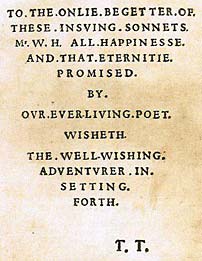
While much remains opaque — and will always remain so — a great deal can be clarified if it is supposed that Sir Henry Neville, rather than William Shakespeare, was the sonnets’ real author. First, the circumstances and meaning of the famous Dedication (above) becomes clear. The Dedication is signed “T.T.”, which is always taken to be Thomas Thorpe, its publisher. But why would the publisher, rather than the author, of a book of poems write its Dedication if its author was still alive? Why would its publisher dedicate the book to a “Mr. W. H.”, described as its “onlie begetter”? How did Thorpe obtain all the 154 sonnets printed in the book, and from whom, given that these must have been written over a long period of time and addressed to many different recipients? And why did Shakespeare not object to their publication? (in 1612, only three years later, “Shakespeare” objected to the publication of someone else’s poem without his permission.)
In my view, only one person could have owned copies of all 154 sonnets: their author, just as only he could legally authorise their publication. Thus, Sir Henry Neville was certainly the author of the book’s Dedication as well as of the sonnets themselves. Since Neville’s endeavour throughout his life was to remain anonymous, he signed the Dedication as from “T.T.” (and not from Thomas Thorpe, who may well not have given his 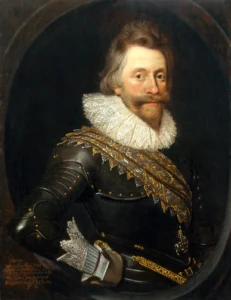 permission to use his actual name). Similarly, Neville may have lacked William Shakespeare’s permission to use the latter’s name for any works other than plays, and so titled the book Shake-spears Sonnets rather than The Sonnets of William Shakespeare.
permission to use his actual name). Similarly, Neville may have lacked William Shakespeare’s permission to use the latter’s name for any works other than plays, and so titled the book Shake-spears Sonnets rather than The Sonnets of William Shakespeare.
“Mr. W.H.”, the likely subject of some of the sonnets, was almost certainly Neville’s close friend Henry Wriothesley, Earl of Southampton (left), in remembrance of the three years the two spent together in the Tower for their roles in the Essex rebellion, when they were stripped of their titles, making Southampton simply Mr. Henry Wriothesley. Their reversed initials W.H. rather than H.W. probably was a private joke between them. By “onlie begetter” Neville may well have meant that it was Southampton who advised him to have his Sonnets published for others to read.
That Neville was the author of the sonnets also fits in extremely well with wider but highly relevant events which occurred at the same time. On May 20, 1609, Shake-spears Sonnets was recorded on the Stationer’s Register (i.e., was officially published). On May 23, 1609, King James officially approved the Charter of the London Virginia Company. A few weeks earlier, on May 2, 1609, Neville’s eldest son, also named Henry, married Elizabeth, daughter of Sir John Smyth (or Smith) at St. Margaret’s Lothbury Church in the City of London. Smythe was an MP and a wealthy landowner and City merchant. The Dedication of the Sonnets was almost certainly connected with the official launch of the London Virginia Company three days after their publication. Apart from the references in the Dedication to “the well-wishing adventurer” — an “adventurer” was an investor in a risky business venture (echoed today in “venture capital”) — at the same time (Rev.) Robert Gray published A Good Speed to Virginia, based on a sermon he delivered at his church, St. Benet Sherehog (sic), where he served as its rector from 1606 until 1612. This work’s dedication reads:
To the Right Noble and Honourable Earls, Barons, and Lords, and to the
Right Worshipful Knights, Merchants, and Gentlemen, Adventurers to the
Plantation of Virginia, all happy and prosperous success, which may either
augment your glory, or increase your wealth, or purchase your eternity …
…Your Honours and Worships in all affectionate well-wishing. R.G.(8)
It seems clear that the author of the Sonnets’ Dedication drew on Gray’s work. The strangely named St. Benet Sherehog, located at the center of the City of London, was near the offices of the London Virginia Company. It seems likely that many of the directors and other officials of the Company heard Gray’s sermon or read his work, a theological justification for the colonisation of Virginia that was directed specifically at the directors of and shareholders in the Company. As noted above, William Shakespeare was not a director of the Company, and had no connection with it. Similarly, Thomas Thorpe (“T.T.”) had no connection with the Company. In complete contrast, Neville was a director of the Company and had a strong financial interest in its success. The publication of the Sonnets three weeks or so after the marriage of Neville’s eldest son to the daughter of a wealthy landowner and merchant also strongly suggests that the first seventeen sonnets, apparently addressed to a young man and advising him to marry “for love of me” and stating “you had a father, let your son say so” suggests that these Sonnets were written by Neville to his son, advising him to marry — which he did. The fact that these sonnets were published first in the collection also suggests that the publication of the book was a celebration of his son’s fortunate marriage.
Salvatore Babones: The Swan, er, Cuckoo of Avon
Although the real meaning of a great many of the sonnets remains unclear, and probably always will, the identification of Sir Henry Neville as their author provides clarification of what was meant by many of them. A particularly striking example is the little-known Sonnet 81:
Or shall I live, your epitaph to make;
Or you survive, when I in earth am rotten;
From hence your memory death cannot take,
A though in me each part will be forgotten.
Your name from hence immortal life shall have,
Though I, once gone, to all the world must die;
The earth can yield me but a common grave,
When you entombed in men’s eyes shall lie.
Your monument shall be my gentle verse,
Which eyes not yet created shall o’er-read,
And tongues to be your being shall rehearse,
When all the breathers of this world are dead.
You still shall live, such virtue hath my pen,
Where breath most breathes, even in the mouths of men.
There, in the words “your name from hence immortal life shall have … Your monument shall be my gentle verse”, Neville is clearly and certainly addressing William Shakespeare, whose “name … immortal life shall have”. This is a precise description of what actually occurred: William Shakespeare became known from that day to this as the immortal writer, while Neville has been totally unknown until recently. If the author of this sonnet was not Neville but William Shakespeare, the poem makes absolutely no sense: it is William Shakespeare’s “name” which has unquestionably achieved “immortal life”, not someone else’s. Stratfordians try to explain this — if they ever try —with explanations that are clearly unconvincing. For instance, the Folger Library’s online presentation of this sonnet states that “the poet, imagining a future in which both he and the beloved are dead, sees himself as being completely forgotten while the beloved will be forever remembered because of the poet’s verse.” But the author of this sonnet has said nothing about his addressee being his “beloved”, and, even more importantly, has emphasized that it is the “name” of the addressee which will have “immortal life”. It is precisely that name which is never stated in this or any other sonnet. In the Arden Shakespeare edition of Shakespeare’s Sonnets (1997), edited by Katherine Duncan-Jones, the editor claims (p. 272), that it is the “fair youth” who is the addressee and whose “name” will have “immortal life”; once again, Sonnet 81 says nothing about a “fair youth”, while again it is precisely the “name” of the addressee which remains unknown throughout the Sonnets. The title page of this work states that “Shake-spear” was their author; sonnet 81 clearly states that he will be given the credit, then and down the ages, for the real author’s work.
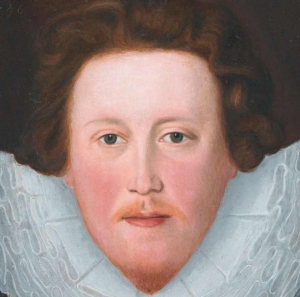
The meaning of many other sonnets also becomes clear once it is known that Sir Henry Neville (above) was their author. A very clear example of this occurs in Sonnet 107:
Not mine own fears, nor the prophetic soul
Of the wide world, dreaming on things to come,
Can yet the lease of my true love control,
Supposed as forfeit to a confined doom.
The mortal moon hath her eclipse endured,
And the sad augurs mock their own presage;
Uncertainties now crown themselves assured,
And peace proclaims olives of endless age.
Now with the drops of this most balmy time
My love looks fresh, and death to me subscribes,
Since ‘spite of him I’ll live in this poor rhyme,
While he insults o’er dull and speechless tribes;
And thou in this shalt find thy monument
When tyrants’ crests and tombs of brass are spent.
The lines “The mortal moon hath her eclipse endured” is almost always presumed to be a reference to the death of Queen Elizabeth in 1603, but the line “supposed as forfeit to a confined doom” has remained mysterious — that is, until it is realised that this is clearly a reference to Neville’s release from the Tower (along with Southampton) by James I soon after the Queen died and he came to the English throne. In contrast, William Shakespeare experienced no known “confined doom”; his status was not changed in any way by the accession of James I, the only exception being that his acting company, the “Lord Chamberlain’s Men” then became the “King’s Men”.
Neville’s family motto Ne Vile Velis (“Do not do anything base [or vile]”) is clearly referred to in several of the sonnets and elsewhere. The clearest example is Sonnet 121, which begins
Tis better to be vile than vile esteemed
When not to be receives reproach of being,
And the just pleasure lost, which is so deemed
Not by our feelings, but by others’ seeing….
The term “vile” seems very unusual in this context, and appears to have been employed because it has a special meaning to the author. (Nothing in this sonnet relates in any way to William Shakespeare.) Another significant use of this term is to be found in the two-line Latin quotation found at the beginning of Shakespeare’s long poem Venus and Adonis, one of his earliest works, published in 1593:
Vilia mirentur vulgus, mihi flavus Apollo
Pocula Castalia plena ministret aqua.
This was translated into English by Christopher Marlowe as
Let base-conceited wits admire vile things,
Fair Phoebus lead me to the Muses’ springs.
The Latin lines used in Venus and Adonis have nothing to do with the substance of Shakespeare’s long poem, but must have made an impression upon Neville owing to their echoing of his name and his family motto.
Another sonnet which appears clearly to relate to Neville’s life is Sonnet 35, which begins
No more be grieved at that which though hast done;
Roses have thorns, and silver fountains mud.
This sonnet was very likely to have been written by Neville shortly after he was sent to the Tower in 1601 and addressed to his fellow prisoner, the Earl of Southampton, whose surname, Wriothesley, was pronounced “Rose-ly”. At his trial, Southampton had stated that Neville was involved in the Essex Rebellion, something which had not been known before, leading to Neville’s arrest and imprisonment.
Three Men Who Knew the Truth — And Said So
Three men, all of whom were close to Neville and his circle, actually stated that he was a notable writer or that “William Shakespeare” was a pseudonym. The first and most remarkable was John Chamber (1546–1604), a noted astronomer, philosopher, and opponent of astrology. Chamber was educated at Merton College, Oxford, where Neville was educated and which was also the home of Sir Henry Savile, Neville’s mentor and friend. Chamber graduated with a B.A. from Merton in 1564 and was a Fellow of the College. He later became Canon of Windsor; Windsor is located eleven miles from Billingbear House, Neville’s country home. In 1583 Chamber was appointed to a committee convened to decide whether the Gregorian Calendar should be adopted by England. Its other members were Savile and Dudley Digges, a relative by marriage of Neville, and the father of Leonard Digges, who wrote commendatory verse published at the beginning of the First Folio.
When, in 1582, Neville and Savile returned from their four-year journeys around Europe, they had obtained for Chamber the manuscript of a work by Barlaam of Calabria, a fourteenth-century mathematician, which Chamber had wished to see. In 1600, Chamber published this book (in Paris, where Neville was Ambassador) as a printed work. It began with the dedication “To the most distinguished man, the Lord [sic] Henry Neville, Ambassador of the Most Serene Queen Elizabeth to the King of France.” The first three paragraphs of this dedication, translated from the original Latin, read as follows:
You may count your family and ancestors in long succession, so that kings’ high courts grant you access. Yet nothing in such great good fortune is so greatly deserving as the admirable quality of your character and the glory of your genius.
It is with these qualities that you manage all your royal duties and conduct such high negotiations; and in the same spirit, leaving the earth behind, you joyfully enter the realm of the stars. Joyfully you go to the stars. where your many faceted qualities make you immortal and admit you amongst the gods before your time.
Too little is your excellence seen by the common people of the earth, were it not for the kindly company of the Muses who sing through you, granting you various arts; the refined Muse of Comedy [“Thalia” in the original] giving you the eloquence to pour forth what you will”(9).
This dedication is truly remarkable. Neville had written nothing whatever under his own name, let alone “Comedies”, while “William Shakespeare had already written eight of his Comedies. He did not write Hamlet until the following year. The last word given here is written in Latin as “Velles”, clearly a pun on Neville’s family 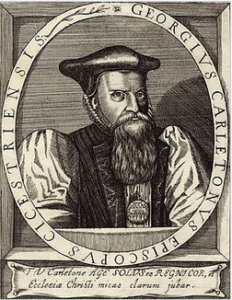 motto, while the phrase “what you Will” (Will written with a capital “V”) strongly suggests that Chamber knew all about his pseudonym.
motto, while the phrase “what you Will” (Will written with a capital “V”) strongly suggests that Chamber knew all about his pseudonym.
The second Man in the Know was George Carleton (1559-1628), later Bishop of Llandaff and the Bishop of Chichester. From 1580 he was a Fellow of Merton College, Oxford, and from 1589 until 1605 was Vicar of Mayfield, Sussex, where Neville had lived from 1582 until 1598. After Neville’s death in 1615, Carleton (left) married his widow, Anne. In 1603 Carleton published Heroici Characteres, written in Latin verse, which was dedicated (in Latin) “To the most distinguished Knight, Henry Neville”, and which exhorted Neville to
grasp firmly the rewards of your achievements, you who will have the Muses to bear witness and your unspotted excellence to guide you.
The book contains two poems in Latin praising Neville, which refer to the Muses and to the theatre of Comedy and Tragedy. One of these poems asks (in Latin) “Who would deny that these should not be exalted on stage in Tragedy?” Again, Neville had no public connection with the “Muses” or with the theatre, a connection which would have been known only to his closest associates. The third member of the knowledgeable trio was (Revd.) Thomas Vicars (1589–1638), also an Oxford graduate and a noted theologian, who, in the 1620s, married Neville’s daughter Anne Neville; he had previously lived in Carleton’s household. In 1628 Vicars published the third edition of a book (in Latin) on Rhetoric. In this edition he added the following to the original Latin text, which contained a list of noted English writers: “To these I believe should be added the famous poet who takes his name from shaking and spear” (“quassatione” and “hasta” in the original). Vicars thus apparently knew that “Shakespeare” was a pseudonym. He was therefore probably the first person to question the identity of the Bard of Avon, two centuries or so before anyone else.These three men all had close associations with Neville, and with Merton College or his family, and were thus in a clear position to know the truth.
Connections Between Neville and Shakespeare
Thomas Digges (1546–95) was a well-known astronomer and mathematician. He was married to Anne St. Leger (1555–1636), the daughter of Sir Warham St. Leger and Ursula Neville (d. 1575), Sir Henry’s cousin, a  fact never made clear in previous discussions of the Digges family and Shakespeare. Digges was an important astronomer who did much to popularise the Copernican Theory of the Solar System, and who must have known Sir Henry Savile (right), Neville’s mentor and another leading astronomer. Among Digges’s sons were Sir Dudley Digges (1583–1639), an MP and a director of the London Virginia Company along with Neville, and also Leonard Digges (1588 –1635), who wrote a commendatory poem published at the beginning of the First Folio (FF). Its author was thus a close relative of Neville’s. Leonard Digges was a minor poet who translated works from Spanish to English, and an Oxford graduate (B.A., University College, 1603), who was close to others involved in the publication of the First Folio, but the choice of Digges to write a commendatory poem for that volume seems somewhat curious unless it is known that he was a relative of the actual author.
fact never made clear in previous discussions of the Digges family and Shakespeare. Digges was an important astronomer who did much to popularise the Copernican Theory of the Solar System, and who must have known Sir Henry Savile (right), Neville’s mentor and another leading astronomer. Among Digges’s sons were Sir Dudley Digges (1583–1639), an MP and a director of the London Virginia Company along with Neville, and also Leonard Digges (1588 –1635), who wrote a commendatory poem published at the beginning of the First Folio (FF). Its author was thus a close relative of Neville’s. Leonard Digges was a minor poet who translated works from Spanish to English, and an Oxford graduate (B.A., University College, 1603), who was close to others involved in the publication of the First Folio, but the choice of Digges to write a commendatory poem for that volume seems somewhat curious unless it is known that he was a relative of the actual author.
The plot the thickens still further. After the death of Thomas Digges in 1595, his widow, Anne, in 1603 remarried Thomas Russell (1570– 1634), who was — believe it or not — one of the two “overseers” of the will of William Shakespeare! (The other “overseer” was a local Stratford solicitor.) An “overseer” of a will was appointed to supervise the work of the will’s executor or executors. The executors of Shakespeare’s will were his daughter, Susanna, and her husband, Dr. John Hall. Shakespeare apparently didn’t trust them, and appointed two other men to supervise their handling of the probate. Shakespeare, however, must have known and trusted Russell to have appointed him. If Sir Henry Neville is the real author, Shakespeare must also 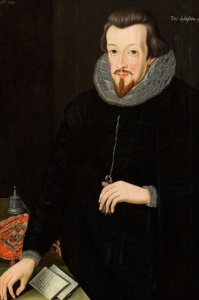 obviously have known him, in order to allow Neville to use his name — for which he was presumably paid — and to act as his producer/director in the theatre. (See also below for an even more startling claimed connection.)
obviously have known him, in order to allow Neville to use his name — for which he was presumably paid — and to act as his producer/director in the theatre. (See also below for an even more startling claimed connection.)
The Performance of Richard II
The day before the Essex Rebellion of 1600. Shakespeare’s Richard II was performed at the request of participants in the rebellion, especially Gelly Meyrick (right), who would be hanged as a result of his involvement in the uprising. The play depicts the deposition of an English monarch. The request by Essex’s supporters was made to the Lord Chamberlain’s Men, Shakespeare’s acting company, who were surprised at the request and described the play as “old and out of use”. Neville had agreed to support the rebellion five days earlier. If he was indeed the play’s real author, it may well have been he who suggested its performance. He also knew that it had been initially performed by the Lord Chamberlain’s Men, rather than any of the other acting companies. Significantly, supposed author William Shakespeare was never questioned, let alone punished, for the play’s performance just before a treasonable insurrection. This fact has always puzzled historians. And neither were any of the other Authorship “candidates”. Neville was fortunate not to be charged for requesting its performance, although he was severely punished for his role in the rebellion.
“By the Dimme Light of Nature”
A famous but mysterious passage in a poem concerning Shakespeare, apparently written by Francis Beaumont to Ben Jonson in 1615, the year of Neville’s death, states that “our heirs shall heare/Preachers apte [sic] to their auditors to showe/ how farr sometimes a man may go/by the dimme light of Nature”. It is followed by the lines “What do you thinke of his/state, who hath now the last that hee [sic] could make/in white and Orange tawny on his backe/at Windsor?” This may well be a description of Neville’s funeral at or near Windsor — Billingbear was eleven miles from Windsor — where Neville may have been laid out “in white and Orange tawny”, the colours of the livery worn by the English Ambassador to France, the highest position Neville ever held. (Until the Second World War, most European ambassadors wore a distinctive uniform or livery when on official diplomatic business.)(10).
Ben Jonson, Gresham College, and the Publication of the First Folio
Ben Jonson (1572–1637) knew Neville and wrote an Ode in his honour. Jonson contributed a commendatory 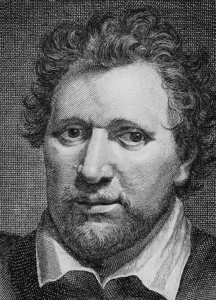 poem to the First Folio (FF), and is often seen as its editor. On 20 October 1623, a month before the preliminary material in FF was believed to have been printed, Jonson appeared in the Court of Chancery to give evidence about the settlement of an estate. There, he signed himself as “Benjamin Jonson of Gresham College, gent.” What Jonson (left) was doing at Gresham College is unknown; he had no known previous connection with this institution.
poem to the First Folio (FF), and is often seen as its editor. On 20 October 1623, a month before the preliminary material in FF was believed to have been printed, Jonson appeared in the Court of Chancery to give evidence about the settlement of an estate. There, he signed himself as “Benjamin Jonson of Gresham College, gent.” What Jonson (left) was doing at Gresham College is unknown; he had no known previous connection with this institution.
Gresham College, which spread the “new learning” in England, was founded in 1597 in the will of Sir Thomas Gresham (c.1518–97), and was physically located in Gresham’s mansion in Bishopsgate in the City of London. Gresham, who founded the Royal Exchange and was a great London merchant, was the uncle of Neville’s mother. Neville’s father was the Chief Mourner at Gresham’s funeral, and the Neville family had certain rights of appointment to its staff. It is a reasonable inference that Sir Henry Neville’s family — presumably his eldest son — secured a post there for Ben Jonson (which Jonson greatly prized, as he very much wanted some academic recognition) as a reward for editing the First Folio and fulfilling his wish to have Shakespeare credited with writing his works. Presumably, too, he was also paid for his efforts. It is otherwise difficult to see what Jonson was doing there.
The financial expenses of producing FF were colossal. It was recently estimated that the cost of printing 750 copies of First Folio was around £250, an enormous sum, and in realistic terms the equivalent today of hundreds of thousands or even millions of pounds, and was described recently by one historian as “enormously expensive”(11). An estimated 333 copies would have had to be sold for the printer to break even(12). Although it is now universally regarded as one of the most important works ever published in the history of Western civilization, it must not be forgotten that it was not necessarily so regarded at the time, and might well have failed to sell more than a handful of copies, leaving its printers with enormous debts. The only precedent for the publication of the works of a playwright was the publication of Ben Jonson’s Works in 1616, which did not see a second printing until 1640(13). Moreover, the printer of the First Folio, Edward Blount (1562–1632), was at the time in severe debt(14). Agreeing to print what might have been an enormous flop at that time might well have bankrupted him, with all of the negative consequences of bankruptcy.
It seems clear that a wealthy man or family must have paid the expenses of printing the First Folio; these expenses might, perhaps, have been paid by Shakespeare’s acting Company, but no evidence exists for this, and it is unclear why they would have risked losing a good deal of money on their venture. Again, positing that Neville’s family paid for the printing of FF provides a clear explanation for what happened.
William Shakespeare and Sir Henry Savile
I now come to something so remarkable that one hardly knows what to make of it. I learned about this only recently, and am grateful to the Neville researcher David Ewald for bringing it to my attention; Ken Feinstein, an excellent Neville researcher, also included it in his online blog some years ago, but I had missed it.
In 1889 James Walter published an attractive, well-illustrated book, Shakespeare’s True Life. On page 61 Walter states that Shakespeare, when travelling to and from Stratford once or twice a year, “made a point of taking Oxford on his route, both going and returning, and that he on every such journey rested some days at [Sir Henry] Savile’s house in Oxford”(!). Walter asserted that this statement was based on what “family traditions assert” and what he heard from the Roman Catholic order at Woolton Wawen, which is a suburb of Stratford-on-Avon. According to Walter, Roman Catholic Cardinal Nicholas Wiseman (1802–65) was also “satisfied that Shakespeare and Savile were in close intimacy during the period of the dramatist’s residence in London.” (Walter’s book is available online.)
I will set out what I know about this truly extraordinary claim. First of all, little could be found in any source about James Walter. He was born in 1817 in Bristol, the son of another James Walter, and died in January 1900 in Twickenham, Middlesex, a leafy suburb about ten miles from central London. By profession, according to several Censuses, he was a major in the 4th Lancashire Artillery Volunteers; it is unclear as to whether he had any form of employment besides being an officer in a Volunteer regiment. Throughout this time, he lived at Stratford Lodge, St. Peter’s Road, Twickenham. Walter had published an earlier volume about Shakespeare in 1878. Although his house and effects were auctioned off shortly after his death and he must have been affluent, he does not appear in the English probate records, which is very unusual. Nothing else about him could be traced, and, in particular, nothing could be found about his interest in Shakespeare or his alleged knowledge of Shakespeare’s connection with Savile.
Cardinal Wiseman — who, one hopes, lived up to his name — was born in Spain to English parents and, in 1850, was made the first Roman Catholic Archbishop of Westminster, when the Catholic hierarchy was re-established in England. A controversial figure, he wrote a book about Shakespeare, published in the year of his death. Judging by his book, James Walter was apparently an enthusiastic Roman Catholic. In recent times Shakespeare has frequently been depicted by biographers as a secret Catholic at a time when this was regarded in England as virtually treasonable, although he was (as noted) baptised, married, and buried as an Anglican. Savile, like Neville, was an emphatic Protestant; both men were attracted to the Earl of Essex because he, and they, wanted to ensure a Protestant succession to the throne after Queen Elizabeth’s death. Neither is known to have been particularly sympathetic to Catholics apart from the universal empathy expressed in Shakespeare’s works.
Let me now set out what I know and don’t know about this extraordinary claim. So far as I am aware, it has  never been set out or discussed in any of the endless number of biographies written about the Bard, or anywhere else. Secondly and centrally, it is difficult to believe that Savile (left), the greatest and most learned Classical scholar in England, and William Shakespeare, who had no education past the age of thirteen or so, had any reason to meet, or the slightest interest in meeting. There is no evidence that Savile ever attended a play in London, or had the slightest interest in the theatre. It is even less likely that, if they met, Shakespeare lit up with enthusiasm when discussing Savile’s magnum opus, an eight-volume edition of the complete works of St. John Chrysostom, which occupied his time for years. It seems to me obvious that the real reason for Shakespeare staying with Savile, if this account is accurate, was to meet with another Fellow of Merton College, Oxford, Sir Henry Neville, where they could discuss Neville’s next plays, and where Shakespeare could give his opinion about whether Neville’s suggestions were good ones, whether actors appropriate for the parts were available, what sources could be used, and so on, and where Shakespeare was probably paid for the use of his name and for acting as Neville’s producer-director in the theatre.
never been set out or discussed in any of the endless number of biographies written about the Bard, or anywhere else. Secondly and centrally, it is difficult to believe that Savile (left), the greatest and most learned Classical scholar in England, and William Shakespeare, who had no education past the age of thirteen or so, had any reason to meet, or the slightest interest in meeting. There is no evidence that Savile ever attended a play in London, or had the slightest interest in the theatre. It is even less likely that, if they met, Shakespeare lit up with enthusiasm when discussing Savile’s magnum opus, an eight-volume edition of the complete works of St. John Chrysostom, which occupied his time for years. It seems to me obvious that the real reason for Shakespeare staying with Savile, if this account is accurate, was to meet with another Fellow of Merton College, Oxford, Sir Henry Neville, where they could discuss Neville’s next plays, and where Shakespeare could give his opinion about whether Neville’s suggestions were good ones, whether actors appropriate for the parts were available, what sources could be used, and so on, and where Shakespeare was probably paid for the use of his name and for acting as Neville’s producer-director in the theatre.
If Neville wanted to keep his authorship a secret, meeting in Oxford, where he was a Fellow of Merton College, was clearly superior to meeting in London. It seems very likely that Savile was also included in these discussions, both to give a second opinion about Neville’s proposals and to suggest possible sources for future plays which would be known to Savile, the great Classicist; he thus may have been considerably more important in this venture than has ever been suggested — of course, no other source has ever suggested that Savile had any connection of any kind with Shakespeare’s plays. Savile would certainly have known that Neville, his student and then close friend, was a secret playwright, in common with the men discussed in Point 7 above.
If all of this was indeed the case, we have just learned more about how “Shakespeare” actually operated in practice than had been learned in the previous 400 years. Keep in mind that the suggestion there were frequent meetings between Savile and Shakespeare is from a source written in the 1890s by an author who unquestionably believed that William Shakespeare wrote the works attributed to him.
What Walter wrote is on the face of it bizarre and unexpected, improbable and arcane: there is nothing whatever to link Shakespeare and Savile, who is nevertheless specifically mentioned, and there is nothing whatever to link Savile with the London theatre or with Shakespeare’s acting company or any other. Every literate person has heard of William Shakespeare, but everyone on Planet Earth who has ever heard of Sir Henry Savile could be seated together comfortably in any McDonald’s on a Monday morning.
It is difficult to see how anyone would or could invent this story. It is also crucial to note that Savile was Neville’s intellectual mentor, while Neville was Savile’s star pupil and close friend for over thirty years. In contrast, there is nothing whatever to link Savile with any of the other Authorship candidates. Anything known further about this claim should certainly be shared with other researchers.
REFERENCES:
Two books making the case for Neville as the real Shakespeare are Brenda James and William D. Rubinstein, The Truth Will Out: Unmasking the Real Shakespeare (Harlow, 2005) and John Casson and William D. Rubinstein, Sir Henry Neville Was Shakespeare: The Evidence (Stroud, 2026). Other pro-Neville books include John Casson, Much Ado About Noting (sic; 2010); Mark Bradbeer and John Casson, Sir Henry Neville Alias William Shakespeare (Jefferson, N.C., 2015); and Brenda James, Henry Neville and the Shakespeare Code (Bognor Regis, 2008). Cogent works questioning whether William Shakespeare wrote the works attributed to him include John M. Shahan and Alexander Waugh, eds., Shakespeare Beyond Doubt?: Exposing an Industry in Denial (Tamarac, Fl., 2013); Katherine Chiljan, Shakespeare Suppressed: The Uncensored Truth About Shakespeare and His Works (San Francisco, Ca., 2011); Bertram Fields, Players: The Mysterious Identity of William Shakespeare (New York, 2005); A.J. Pointon, The Man Who Was Never Shakespeare (Tunbridge Wells, 2011); and Diana Price, Shakespeare’s Unorthodox Biography: New Evidence of an Authorship Problem (Westport, Conn., 2012). See also Elizabeth Winkler, Shakespeare Was a Woman and Other Heresies (New York, 2023).
NOTES
- On Shakespeare’s knowledge of Italy, see Alexander Waugh, “Keeping Shakespeare Out of Italy,” in Shahan and Waugh, eds., op. cit., pp. 72–85, and Richard Paul Roe, The Shakespeare Guide to Italy: The Bard’s Unknown Travels (New York, 2011).
- See Mark Eccles, Shakespeare in Warwickshire (Madison, Wisconsin, 1961), pp. 72–75, cited in Katherine Duncan-Jones and H.R Woudhuysen, eds. Shakespeare’s Poems (London, 2007), p. 464.
- The most comprehensive examinations of the clear-cut references to the Strachey Letter in The Tempest can be found in Robert Ralston Cawley, “Shakespeare’s Use of the Voyagers in The Tempest,” Proceedings of the Modern Language Association, Vol. 41, No. 3, September 1926, pp. 688 – 726. See also E. P. Kuhl, “Shakespeare and the Founders of America: The Tempest,” Philological Quarterly, Vol. XLI (1962), pp. 133 -146, and Scott McCrea, The Case For Shakespeare: The End of the Authorship Question (Westport, Conn., 2005), pp. 203 –205. On Strachey, see the biography by S.G. Culliford, William Strachey, 1572 – 1621 (Charlottesville, Virginia, 1965).
- Barry R. Clarke, “The Virginia Company and The Tempest,” Journal of Drama Studies, Vol. 5 (July 2011), pp. 13–27.
- See Dan Falk, The Science of Shakespeare: A New Look at the Playwright’s Universe (New York, 2014), pp. 192–215, and Peter Usher, “Jupiter and Cymbeline,” The Shakespeare Newsletter (Spring 2003), pp. 7–12.
- On Sir John Salusbury as the subject of Shakespeare’s poem, see Duncan-Jones and Woodhuysen, eds., op. cit., pp. 91–124, and E.A.J. Honigmann, Shakespeare: The Lost Years (Manchester, 1998), pp. 91–213.
- Frank J. Burgoyne, Collotype Facsimile and Type Transcript of an Elizabethan Manuscript … (London, 1904).
- Chiljan, op. cit., p. 314.
- Casson and Rubinstein, op. cit., p. 118.
- On this matter, see Mark Bland, “Francis Beaumont’s Verse Letters to Ben Jonson and ‘the Mermaid Club’,” English Manuscript Studies, Vol. 12 (2005), pp. 139–179. Neville was listed as a member of the “Mermaid Club”, which also allegedly included Shakespeare, Ben Jonson, Beaumont and Fletcher, and other noted literary figures. There is some doubt as to whether this club actually existed, but the fact that Neville was listed as a member is of interest, as he had no ostensible connection with the London literary and theatrical worlds.
- Eric Rasmussen, “Publishing the First Folio”, in Emma Smith, ed., The Cambridge Companion to Shakespeare’s First Folio (Cambridge, 2016), p. 27.
- Ibid.
- Ibid.
 Sign In
Sign In 0 Items (
0 Items ( Search
Search









Not Edward de Vere?
Incidentally, a few years ago I saw Derek Jacobi say he was certain someone else wrote the Bard’s works, but just last month in a show on Prime (I think it was – hard to keep track these days) I thought he was a bit on the fence.
Apart from being fascinated by the lengths to which people go in their search for the ‘real’ Shakespeare, I find myself wondering if they have the capacity to enjoy the works that bear his apparent authorship.
Salvatore,
All very interesting, but it left me wondering about motivation. Why would such a prominent person as Sir Henry Neville want to conceal his ability? Would he not have been proud of his achievements and wish readers to know the real author by the customary, simple act of signing his name on each literary piece? Geoff S
The key question. Presumably because he could express himself freely in his plays, some of which concerned the death of Kings, but not in public life. Also, playwriting was unseemly for a potential major Court official as Neville hoped to be. Once he had his identity as Shakespeare in place, it worked well.
I would like to make some additions to my article on Sir Henry Neville, specifically about the Latin quotation found at the beginning of Shakespeare’s long poem “Venus and Adonis”. First, I wish to acknowledge the work of Neville researcher James Leyland, from whom my assertions about this Latin quotation are derived, and whom I should have specifically acknowledged. Neville’s family motto “Ne Vile Velis” should be translated as “wish for no base thing.” His Latin family motto is clearly referred to several times in the works of “Shakespeare.” One of the most important is this use at the beginning of” Venus and Adonis.” which begins “Vilia miretur…” This quote, from Ovid, was plainly a reworking of Neville’s motto as “Vilia miretur vulgus,” “let common people admire base things.” The two phrases are almost interchangeable in meaning, with “vilia” being simply the plural form of “vile,” as any Elizabethan schoolboy would have known. This was clearly an elegant way of noting that Neville was the real author of “Venus and Adonis,” the first published work to state that its author was William Shakespeare. I am grateful to James Leyland for this information. (William Rubinstein)